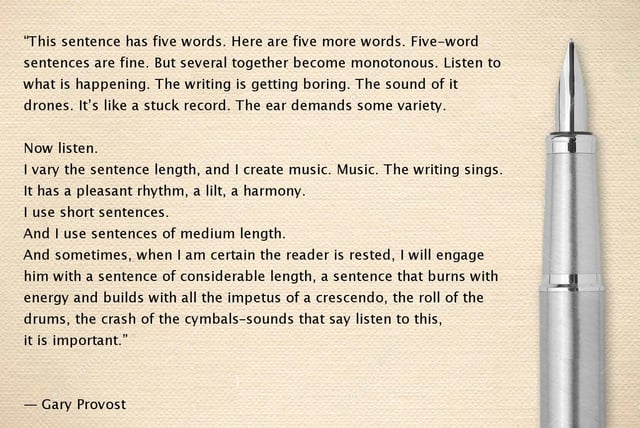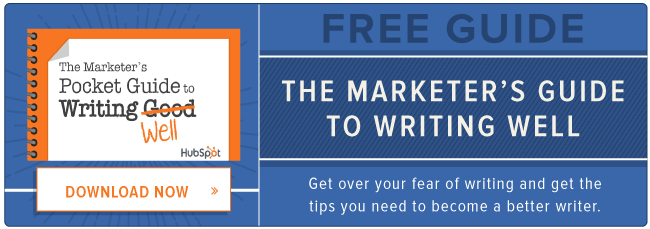I wrote my first blog post two summers ago. And I wish I could erase it from the internet. Reading it is like looking at my middle school Facebook pictures — it’s almost too cringe-inducing.
Maybe I shouldn’t be so hard on myself, though. I had just finished my freshman year of college, and the last paper I wrote was about the Odyssey. I didn’t know what I was doing.
But after completing several content marketing internships and taking classes like business writing, electronic journalism, and creative writing, I’ve learned how to write for an audience. Blogging is almost second nature to me now.
If you’re just starting out with blogging and struggling to produce something you’re truly proud of, don’t get discouraged. You don’t need to enroll in a bunch of writing classes or join a content marketing team to become a good blogger (although it certainly doesn’t hurt). You can hone your writing skills online — and this blog post can be one of your bookmarkable resources.
Listed below are eight essential writing tips I’ve gleaned from all my classes and content marketing experience. Check them out to learn how to engage your audience with clear, concise, and compelling content — and make me even more embarrassed about the first blog post I ever wrote.
8 Essential Writing Tips for Crafting Clear, Concise, and Compelling Content
1) Trim the fat.
The more unnecessary words your trim from your writing, the easier it is to understand. Concise writing is lean. And readers can zip through it with little effort. To sharpen your writing, follow the four pointers below:
- Avoid linking verb phrases like “Sam was writing about his van.” “Sam wrote about his van.” sounds more forceful. Linking verbs have a passive effect, which is why they can’t pack much of a punch.
- Change prepositional phrases like “The decision of the board was final.” to “The board’s decision was final.” Prepositional phrases make sentences longer and harder to follow.
- When a noun ends in -tion, change the noun to a verb. For example, “They will collaborate to create a new style guide.” sounds cleaner than “They will collaborate in the creation of a new style guide.”
- Reduce verb phrases like “The results are suggestive to the fact that on-page SEO still works.” to simple verb phrases like “The results suggest that on-page SEO still works.” The latter sounds much smoother.
2) One sentence should only cover one idea.
A clear sentence that’s easy to understand covers one main idea. But sometimes writers focus too much on sounding smart rather than conveying information in a simple way. This can lead to complex sentences that confuse readers.
You must remember your readers don’t care about your writing prowess. They want to quickly understand the solutions to their own problems, and simple sentences can fulfill that need.
Use the Hemingway App to gauge whether your sentences are bold and clear.
3) Sentences don’t live in isolation.
If you want to craft a compelling sentence, you need to account for its surrounding sentences first. Using the same word in consecutive sentences or covering similar ideas in two different sentences is redundant. To create a more stimulating experience for your readers, vary your language and cut repeat information.
Use Power Thesaurus to replace overused words with dynamic synonyms.
4) Vary sentence length and structure.
I saw a graphic called “How to Write” on Twitter about a year ago, and it took my writing skills to the next level. Take a look.

Humans crave variety. And just like how short, medium, and long sentences complement each other, simple and compound sentences complement each other too.
Your writing becomes repetitive and boring when your sentences have the same structure or length. Diverse sentences make your writing pleasant to read.
5) Scrap the cliches.
Would it be cliche to begin this paragraph with a cliche? I thought so. That’s why I didn’t do it. Cliches sap your content’s originality.
People use these phrases so much that they lose their true meaning. Some studies even claim that figures of speech like “hungry as a horse” or buzzwords like “leverage” can’t activate the prefrontal cortex, which is responsible for experiencing emotions. They’re too stale to impact you.
A good way to test cliches is by asking yourself if you’ve heard the term before. If so, aim to express your idea in a new, fresh way. You can also nix cliches by filtering your content through a cliche finder tool.
6) Appeal to the senses.
Good fiction writers can make their readers experience the stories they write. By using concrete details that appeal to their reader’s senses, they can paint vivid pictures with only words.
Skeptical? Well, in a 2012 study at Emory University, researchers monitored participants’ brain activity when they read metaphors involving texture. Metaphors like “He had leathery hands,” lit up their sensory cortex, which is responsible for perceiving texture through touch. When they read a similar phrase like “he had strong hands,” their sensory cortex didn’t activate.
“Leathery” is a concrete detail that appeals to touch. And it places readers into the exact scene the writer described. Metaphors and similes also help people visualize things by comparing a concrete picture with an abstract idea.
Business writing definitely differs from creative writing, but you can still harness the power of sensory language in your blog posts. If your readers can see, hear, touch, smell, or taste your ideas, then they’ll be hooked on your content.
Having trouble grasping this concept? Here are some examples:
- Visual: “You immediately glue your eyes to the skip button’s countdown clock and wait … until those lingering seconds finally slug by.” – Can you see how long this ad is?
- Auditory: “But the 20 pen slips below were so hilarious and shocking that my laughter pierced through all my colleagues’ noise-canceling headphones.” – Can you hear his obnoxious laugh?
- Touch: “Let your well-formatted paragraphs put her attention in a guillotine hold.” – Can you feel how captivated she is?”
- Smell and taste: “Turn bland writing into zesty sound bites.” – How strong was that quip’s flavor?
7) Let things go.
When you write an elegant paragraph or sentence, your inner author latches onto it. But even if it doesn’t fit within the scope of your content, you still might try to force it in there. You can get too attached to let it go.
Paragraphs or sentences that don’t deepen your readers’ understanding of the topic, provide new information, or spark interest in the next section are just fluff. And all fluff does is muddle your writing.
Instead of building around fluff, strip it away and start something new from scratch. Abandoning beautiful writing is always hard, but if it doesn’t provide value to your readers, let it go.
8) Take a break.
Have you ever reread your final draft so much that you can’t determine whether it’s Neil Patel good or high school essay bad? You can even convince yourself that a lousy draft looks great if you’ve worked on it for long enough.
Before you submit your final draft, it’s crucial to walk away from it. Forgetting about your work will help you develop fresh editing eyes that can discover overlooked errors and new creative opportunities.
Eddie Shleyner, copywriter and content marketer at Workforce Software, follows “The Rule of 12” when he edits his blog posts. After writing his final draft, he walks away for 12 hours. Then he makes his final round of edits, where he always finds a mistake or a better way to polish his copy.
What writing tips do you find useful? Let us know on Twitter!
![]()






